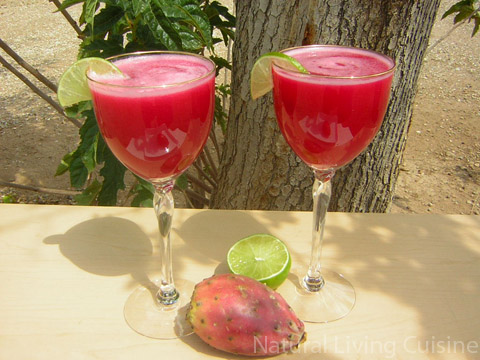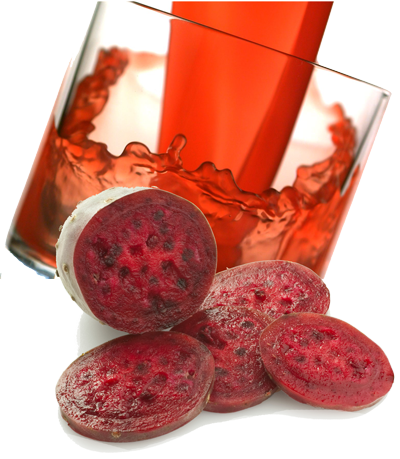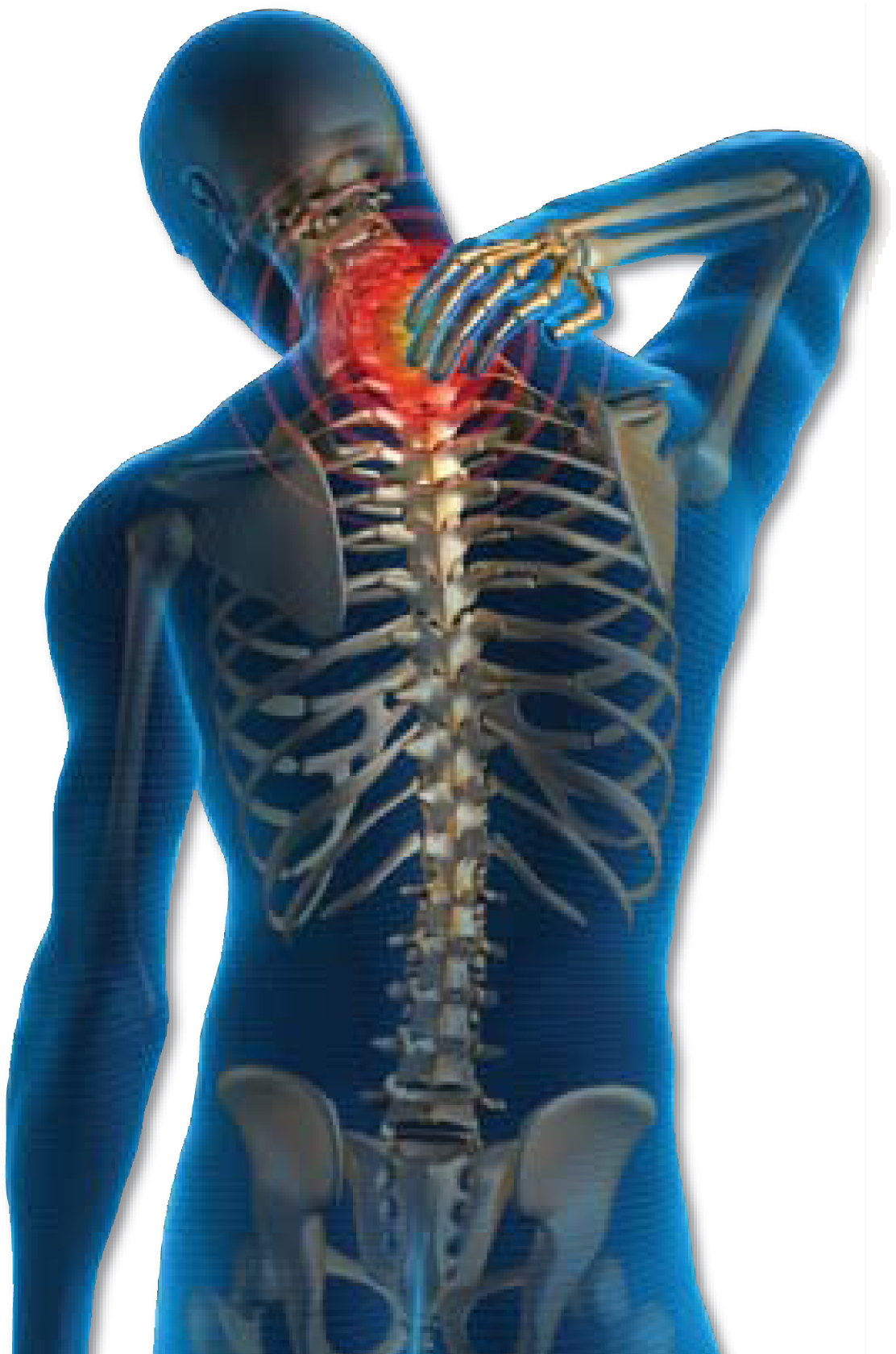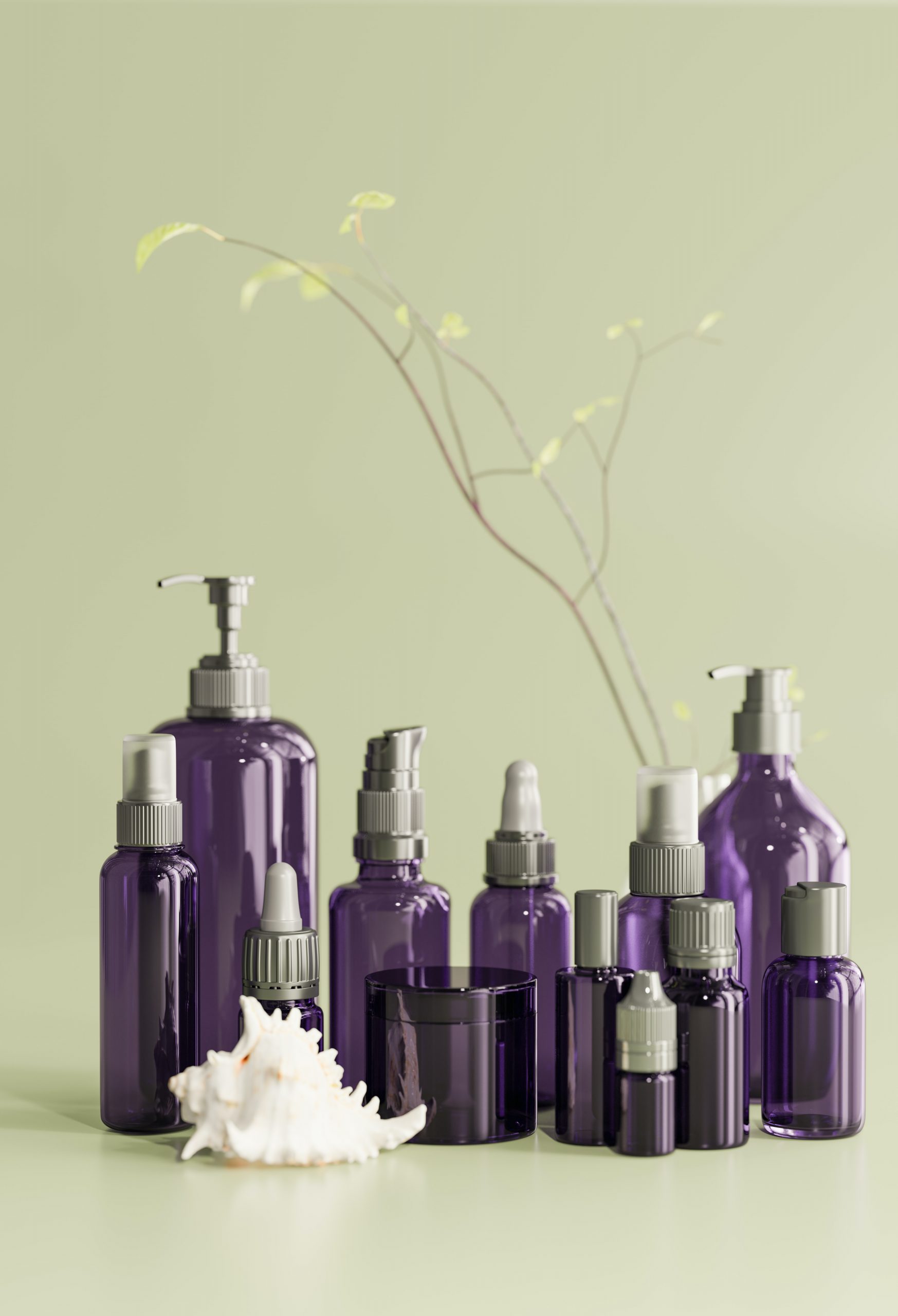
Nopal juice is made from figs or fruit of a Nopal Cactus plant. This particular cactus (Opuntia Ficus Indica) is found in the northern part of Mexico and along the southwest states of the USA known as The Sonoran Desert. The extreme conditions of the Sonoran Desert are due to a high fluctuation of temperatures – from over 120 degrees during the day down to below freezing at night. The nopal cactus has adapted to survive and as a result produces very potent anti-oxidants. Because of these potent anti-oxidants, this cactus fruit has been widely used for centuries for medicinal purposes due to the powerful Bioflavonoids it possesses.

There are many species of Nopal that grow around the world, however the region with the most extreme temperature fluctuation have shown to produce more potent nopal fruit. The same can be said of other types of foods that also contain these anti-oxidants. Beets can contain up to 6 of the 24 Bioflavonoids; Rainbow Swiss chard contains up to 12 Bioflavonoids. Nopal fruit from the Sonora Desert when wild-harvested at the peak of ripeness can contain all 24 Bioflavonoid types.
The Power of Bioflavonoids
The word Bioflavonoid is a broad term for the scientific word ‘betalains’ – which are the pigments that give the Nopal cactus fruit its vibrant pink color and were once thought to be only plant pigments with no real health benefits. But recent scientific research has identified 24 different betalains known for their high antioxidant capacity, and each one completes a specific need in human health by supplying structure and function to every human cell. They serve as anti-inflammatory nutrients to help quench the fire of chronic inflammation.

Postharvest Biology and Technology of Tropical and Subtropical Fruits
https://www.sciencedirect.com/topics/agricultural-and-biological-sciences/betalain
https://www.sciencedirect.com/book/9781845697334/postharvest-biology-and-technology-of-tropical-and-subtropical-fruits
Scientific research shows that the bioflavonoids found in the Nopal cactus fruit may help to detoxify your body, eliminating the poisons we encounter every day. Bioflavonoids may also help the body reduce inflammation, protecting you from a wide variety of disorders. Regardless of where inflammation begins or what process it affects, Bioflavonoids help reduce the activity of the enzymes known to cause all inflammation. This explains why people with very diverse health concerns find benefits from Bioflavonoids: they may help reduce inflammation no matter where it exists!
Medicinal agents in the metabolic syndrome. “According to this study Prickly Pear Cacti. (Opuntia Ficus- Indica Cochlospermum vitifolium (Willd.) Spreng) whose many properties against diabetes and hypercholesterolemia have been empirically known for many years in humans.”
Cardiovasc Hematol Agents Med Chem. 2008 Oct;6(4):237-52.
https://www.ncbi.nlm.nih.gov/pubmed/18855636
Bioflavonoids, the nature-inspired pigments, in health and diseases. “According to this study it seems that treatment with bioflavonoids and bioflavonoid-rich diets is not only nontoxic but could also prove to be a promising alternative to supplement therapies in oxidative stress-, inflammation-, and dyslipidemia-related diseases such as stenosis of the arteries, atherosclerosis, hypertension, and cancer, among others.”
Crit Rev Food Sci Nutr. 2018 May 30:1-30
https://www.ncbi.nlm.nih.gov/pubmed/29846082
Important functions of Bioflavonoids
Bioflavonoids support the structure and function of the cell as mentioned before. They also work to neutralize toxins by supporting your natural detoxification processes as well as draining away accumulations of toxic waste. Bioflavonoids are a protein-bound antioxidant that may do more than help slow aging. Bioflavonoid antioxidants may help the body reduce inflammation, detoxify the cell and restore the balance between the inside and outside of the cell for optimal cellular function. While many antioxidants have been claimed to have different health benefits, the bioflavonoid antioxidant is specifically studied to understand how they may help the body reduce inflammation on a measurable and therapeutic level. Multiple studies show that bioflavonoid antioxidants can help the human cell detoxify and remove unwanted and dangerous toxins which may help reduce inflammation.
How Drinking Nopal Juice can help the body

Inflammation – The Silent Killer
Inflammation is your immune system’s response to damage. This damage can arise from trauma, bacterial, viral or parasitic infection, stress, genetic abnormalities, metabolic disorders and a host of other sources. Certain lifestyle conditions can also contribute to inflammation: poor diet, stress, being overweight, a sedentary lifestyle and smoking. Inflammation can cause redness, swelling, heat, pain and loss of function.

As the body is exposed to daily toxins and other harmful stimuli, cells wither, collapse and eventually die. In 2004 Time Magazine published at article title Health: The Fires Within which provides insight on the effects inflammation has on the body, causes, remedies and what happens when chronic inflammation is ignored.
There have been 100’s of studies done by The National Institute of Health proving that Betalain’s/Bioflavonoids may help the body four vital ways:
- Reduce inflammation
- Detoxify the body
- Achieve optimal cellular health
- Protect against premature aging
Research & Science
Over 200 scientific papers have been published on the benefits and attributes of Nopal. These reports are found in the highest quality, peer-reviewed journals and are supported by the National Institutes of Health database to ensure that the conclusions were valid.
The scientific papers chronicle improvements in cell function, immunity, detoxification – and especially a reduction in inflammation. There is a wide array of information found on sites like pubmed.gov that provide comprehensive studies that mention topics like obesity, brain protection, immune support, blood sugar benefits and much more! See what the scientific research community has to say about these incredible nutrients!
Opuntia Ficus Indica


- This study suggests Betanin a betacyanin pigment purified from fruits of Opuntia ficus-indica induces apoptosis in human chronic myeloid leukemia Cell line-K562.
“Betalains are water-soluble nitrogenous vacuolar pigments present in flowers and fruits of many caryophyllales with potent antioxidant properties. In the present study the antiproliferative effects of betanin, a principle betacyanin pigment, isolated from the fruits of Opuntia ficus-indica, was evaluated on human chronic myeloid leukemia cell line (K562). The results show dose and time dependent decrease in the proliferation of K562 cells treated with betanin with an IC(50) of 40 microM. Further studies involving scanning and transmission electron microscopy revealed the apoptotic characteristics such as chromatin condensation, cell shrinkage and membrane blebbing in humans.”
(Phytomedicine. 2007 Nov;14(11):739-46.) - Modulation of intracellular calcium concentrations and T cell activation by prickly pear polyphenols.
“According to this study Opuntia ficus indica (prickly pear) polyphenolic compounds (OFPC) triggered an increase in [Ca2+]i in human Jurkat T-cell lines in humans.”
(Mol Cell Biochem. 2004 May;260(1-2):103-10.) - Effect of Opuntia ficus indica on symptoms of the alcohol hangover. “According to this study an extract of the Opuntia ficus indica (OFI) has a moderate effect on reducing hangover symptoms, apparently by inhibiting the production of inflammatory mediators in adult humans.”
Arch Intern Med. 2004 Jun 28;164(12):1334-40 - Opuntia (Cactaceae) plant compounds, biological activities and prospects – A comprehensive review. “According to this study Opuntia species are utilized as local medicinal interventions for chronic diseases and as food sources mainly because they possess nutritional properties and biological activities in humans.” Food Res Int. 2018 Oct;112:328-344
- According to this study Antioxidant bioflavonoids help protect the cells that line the interior surface of blood vessels and lymphatic vessels.
“It has been suggested that some pigments would have antioxidant properties and that their presence in dietary constituents would contribute to reduce the risk of oxidative stress-correlated diseases. Among others, inflammatory response depends on redox status and may implicate oxidative stress. Vascular endothelial cells are a direct target of oxidative stress in inflammation. We have tested the impact of the free radical scavenger and antioxidant properties of bioflavonoids/betalains from the prickle pear in an in vitro model of endothelial cells. Here we show the capacity of bioflavonoids/betalains to protect endothelium from cytokine-induced redox state alteration, through ICAM-1 inhibition in humans.”
(Ann N Y Acad Sci. 2004 Dec;1028:481-6.) - The comparison of betalain composition and chosen biological activities for differently pigmented prickly pear (Opuntia ficus-indica) and beetroot (Beta vulgaris) varieties. “This study suggests Bioflavonoid/Betalain composition analysis and antioxidant profiles confirmed that the content and composition of these pigments is strongly correlated with the antioxidant activity of tested plant extracts measured by spectrophotometric methods and CAA test in humans.” Int J Food Sci Nutr. 2019 Jun;70(4):442-452
- Extension of life-span using a RNAi model and in vivo antioxidant effect of Opuntia fruit extracts and pure boiflavonoids/betalains in Caenorhabditis elegans.“This study suggests Bioflavonoids/Betalains are nitrogenous plant pigments known for their high antioxidant capacity via pharmacology.” Food Chem. 2019 Feb 15;274:840-847
- Bioflavonoids/Betalains, the nature-inspired pigments, in health and diseases.
“It seems that treatment with bioflavonoids/betalains and bioflavonoid/betalain-rich diets is not only nontoxic but could also prove to be a promising alternative to supplement therapies in oxidative stress-, inflammation-, and dyslipidemia-related diseases such as stenosis of the arteries, atherosclerosis, hypertension, and cancer, among others.” Crit Rev Food Sci Nutr. 2018 May 30:1-30 - This study suggests Cactus (Opuntia ficus-indica) protects against oxidative damage induced by the mycotoxin zearalenone in Balb/C mice. “According to this study Zearalenone (ZEN) is one of the most widely distributed fusarial mycotoxins which is encountered at high incidence in many foodstuffs. ZEN was associated with different reproductive disorders in animals… Oxidative damage seems to be a key determinant of ZEN induced toxicity in both liver and kidney of Balb/c mice… It could be concluded that cactus cladodes extract was effective in the protection against ZEN hazards… This could be relevant, particularly with the emergent demand for natural products which may counteract the detrimental effects of oxidative stress and therefore prevent multiple human diseases.”
(Food Chem Toxicol. 2008 May;46(5):1817-24.) - According to this study Opuntia ficus indica extract protects against chlorpyrifos-induced damage on mice liver. “This original study investigates the role of Opuntia ficus indica (cactus) cladodes extract against liver damage induced in male SWISS mice by an organophosphorous insecticide, the chlorpyrifos (CPF)… These results allow us to conclude firstly that CPF is hepatotoxic and secondly that Opuntia ficus indica stem extract protects the liver and decreases the toxicity induced by this organophosphorous pesticide.”
(Food Chem Toxicol. 2008 Feb;46(2):797-802.) - Per this study Opuntia ficus indica (L.) Mill. fruit juice protects liver from carbon tetrachloride-induced injury. “Opuntia ficus indica fruit juice contains many phenol compounds, ascorbic acid, betalains, betacyanins, and a flavonoid fraction, which consists mainly of rutin and isorhamnetin derivatives. Hepatoprotection may be related to the flavonoid fraction of the juice, but other compounds, such as vitamin C and bioflavonoids/betalains could, synergistically, counteract many degenerative processes by means of their antioxidant activity in rats.”
(Phytother Res. 2005 Sep;19(9):796-800.) - According to this study Inhibition of nitric oxide synthase expression in activated microglia and peroxynitrite scavenging activity by Opuntia ficus indica var. saboten. “These results imply that Opuntia ficus indica may have neuroprotective activity through the inhibition of Nitric Oxide production by activated microglial cells and peroxynitrite scavenging activity in mice.” (Phytother Res. 2006 Sep;20(9):742-7.)
- Per this study the Neuroprotective effects of antioxidative flavonoids, quercetin, (+)-dihydroquercetin and quercetin 3-methyl ether, isolated from Opuntia ficus-indica var. saboten. “These results indicate that quercetin, (+)-dihydroquercetin, and quercetin 3-methyl ether are the active antioxidant principles in the fruits and stems of Opuntia ficus-indica var. saboten exhibiting neuroprotective actions against the oxidative injuries induced in cortical cell cultures in rats.” (Brain Res. 2003 Mar 7;965(1-2):130-6.)
- According to this study Opuntia ficus indica (nopal) attenuates hepatic steatosis and oxidative stress in obese Zucker (fa/fa) rats. “This study suggests that nopal consumption attenuates hepatic steatosis by increasing fatty acid oxidation and VLDL synthesis, decreasing oxidative stress, and improving liver insulin signaling in obese Zucker (fa/fa) rats.”
J Nutr. 2012 Nov;142(11):1956-63
How much Nopal Cactus Juice should I drink?

The recommended loading dose for Nopal Cactus Juice is 3 ounces twice a day, on an empty stomach. 1 bottle will last you around 5 days and from there you can continue on a “maintenance” dose of 2 ounces twice per day – which will allow you to make a 4-pack last an entire month – for 1 person. It’s recommended that you listen to your body if you’re craving more – a lot of that will depend on your body’s level of inflammation.
The Bioflavonoids found in Nopal Cactus Juice act as “inflammation seekers” and will usually target the most inflamed tissue first – and begin lifting the toxic waters and flushing them out of your body. Be sure to test your range of motion before you being drinking Nopal Cactus Juice and pay attention to your range of motion and flexibility as you allow the vital nutrients to work.
Nopal juice is made from figs or fruit of a Nopal Cactus plant. This particular cactus (Opuntia Ficus Indica) is found in the northern part of Mexico and along the southwest states of the USA known as The Sonoran Desert. The extreme conditions of the Sonoran Desert are due to a high fluctuation of temperatures – from over 120 degrees during the day down to below freezing at night. The nopal cactus has adapted to survive and as a result produces very potent anti-oxidants. Because of these potent anti-oxidants, this cactus fruit has been widely used for centuries for medicinal purposes due to the powerful Bioflavonoids it possesses.


